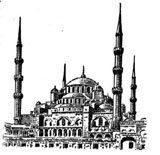
Discovering the Catholic Church’s Eastern Rite
A BIG BLAST OF 'SMELLS & BELLS'
My wife and I recently invited a young Catholic couple to attend our parish church one Sunday. Afterward, over coffee and donuts in the social hall, the wife leaned over and asked me in a stage whisper, “This is a Catholic church, right?”
Her question is typical of Roman Rite Catholics who attend their first Eastern Rite liturgy. It’s the question I asked myself the first time I witnessed the exotically beautiful ritual. What Western Catholics call the Mass, Eastern Catholics call the Divine Liturgy. There’s no ontological difference between the two. Both are the same thing: making present Christ’s redemptive sacrifice on Calvary. Externally, however, there are many differences.
The typical Eastern Rite Divine Liturgy is long, about an hour and a half. The church interior is covered with icons of biblical scenes and the Fathers and Doctors of the early Church. The Blessed Virgin Mary, the saints, and angels — that “cloud of witnesses” who surround us, as spoken of in Hebrews 12:1 — are depicted in a profusion of color. The sanctuary is separated from the body of the church by an iconostasis, each panel formed by a life-size icon of Christ, the Blessed Virgin Mary, angels, and saints. The altar is small and square, with an ornate tabernacle placed at the back center. The entire Liturgy is sung, with the hymns and antiphons alternating among priest, deacon, and congregation. The robust singing impressed and attracted me when I attended my first Liturgy. The people, led by a cantor, participated in prayer with gusto. The hymns are beautiful and theologically rich. The prayers, hymns, and actions are a vivid reflection of the early Church liturgy (the same is true, of course, of the Traditional Latin Mass). Then there is the heavy use of incense, bells, processions, bowing, and the custom of everyone making the sign of the cross every time the words “Father, Son, and Holy Spirit” are uttered.
All of these elements of the Divine Liturgy express the deepest sentiments and aspirations of the soul, and dispose the mind toward heaven. Most Roman Rite Catholics find it foreign and odd at first, but the oddness quickly fades as the Liturgy becomes familiar, and soon they revel in the signs and symbols. They drink in the ancient splendor of the Eastern Rite, an oasis of dignified worship (often in English) amidst the arid banality of many Roman Rite parishes. Their thirst for transcendent, aesthetically beautiful worship is slaked.
The Eastern Rites of the Catholic Church include the Antiochene, Chaldean, Armenian, Alexandrian, and Byzantine Rites, and the various “sub-Rites” contained within these groupings. Each of these Rites is in full communion with the Bishop of Rome. They are fully Catholic, though they preserve (fiercely, at times) the cultural heritage from which they sprang.
You May Also Enjoy
Why do Catholics (and Jews) reject prostration as a regular posture of liturgical worship, and why do Muslims use it as the signature posture of daily salat?
The Hebrew-ness of Catholicism is a critical element of it. When we excise Hebrew elements from our prayers, we sever roots that feed our religion.
Waugh contended that the quiet and faithful "middle rank of the Church" are precisely those whose concerns were not being heeded by the Church or her Council.

